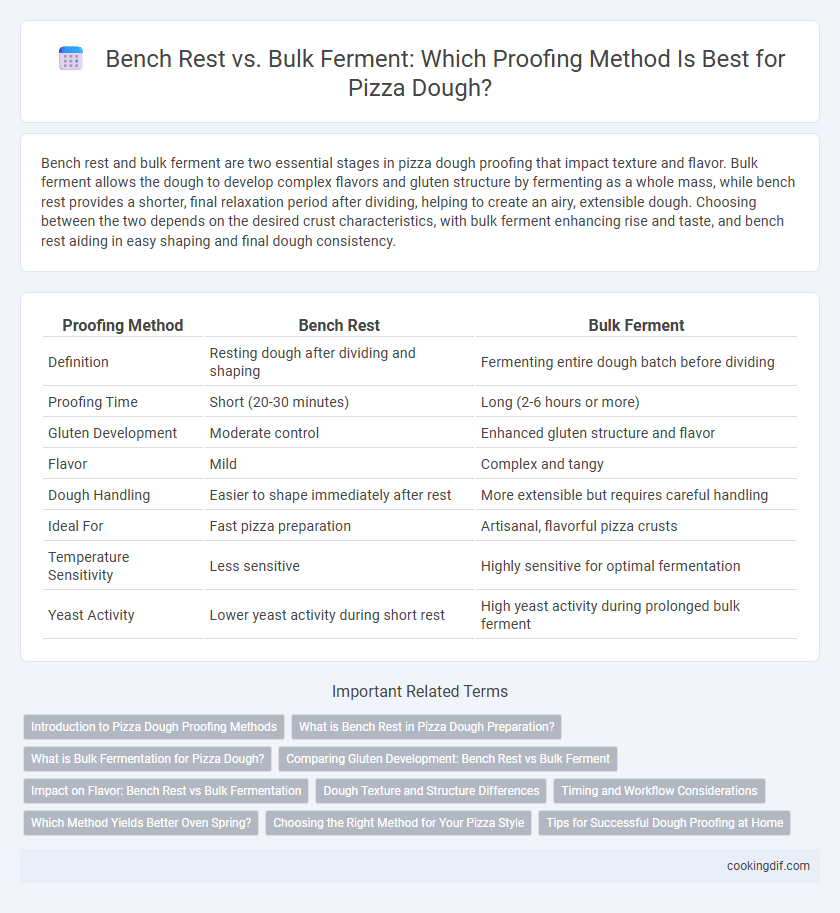Bench rest and bulk ferment are two essential stages in pizza dough proofing that impact texture and flavor. Bulk ferment allows the dough to develop complex flavors and gluten structure by fermenting as a whole mass, while bench rest provides a shorter, final relaxation period after dividing, helping to create an airy, extensible dough. Choosing between the two depends on the desired crust characteristics, with bulk ferment enhancing rise and taste, and bench rest aiding in easy shaping and final dough consistency.
Table of Comparison
| Proofing Method | Bench Rest | Bulk Ferment |
|---|---|---|
| Definition | Resting dough after dividing and shaping | Fermenting entire dough batch before dividing |
| Proofing Time | Short (20-30 minutes) | Long (2-6 hours or more) |
| Gluten Development | Moderate control | Enhanced gluten structure and flavor |
| Flavor | Mild | Complex and tangy |
| Dough Handling | Easier to shape immediately after rest | More extensible but requires careful handling |
| Ideal For | Fast pizza preparation | Artisanal, flavorful pizza crusts |
| Temperature Sensitivity | Less sensitive | Highly sensitive for optimal fermentation |
| Yeast Activity | Lower yeast activity during short rest | High yeast activity during prolonged bulk ferment |
Introduction to Pizza Dough Proofing Methods
Bench rest and bulk ferment are essential pizza dough proofing methods that influence texture and flavor development. Bulk ferment occurs immediately after mixing, allowing yeast activity to develop gluten and aromatic compounds, while bench rest follows bulk ferment and provides dough relaxation for easier shaping. Understanding these stages helps optimize dough structure and enhances the final pizza crust's chewiness and rise.
What is Bench Rest in Pizza Dough Preparation?
Bench rest in pizza dough preparation refers to a short resting period, typically 20 to 30 minutes, where the dough is allowed to relax after initial mixing and kneading. This process helps to relax gluten strands, making the dough easier to shape into pizza bases without tearing. Unlike bulk ferment, which is a longer fermentation stage where the entire batch of dough develops flavor and texture, bench rest primarily aids in dough handling and shaping.
What is Bulk Fermentation for Pizza Dough?
Bulk fermentation for pizza dough is the initial rising phase where the dough ferments as a whole mass, allowing yeast to produce carbon dioxide and develop flavor. This process enhances dough elasticity, texture, and taste by promoting enzymatic activity and gluten development. Compared to bench rest, bulk fermentation offers more consistent fermentation and improved dough maturation, resulting in a superior crust structure.
Comparing Gluten Development: Bench Rest vs Bulk Ferment
Bench rest proofing promotes gluten development through a short, controlled resting period that allows dough to relax and hydrate, enhancing extensibility for easier shaping. Bulk ferment proofing fosters more extensive gluten network formation by enabling longer enzymatic activity and gas retention during fermentation, resulting in improved dough structure and elasticity. Comparing both, bulk fermentation typically yields stronger gluten development and superior dough strength, while bench rest offers quicker processing with moderate gluten improvement.
Impact on Flavor: Bench Rest vs Bulk Fermentation
Bulk fermentation enhances dough flavor by allowing yeast and bacteria to produce organic acids and alcohols over an extended period, resulting in a more complex and tangy taste profile. Bench rest offers a shorter proofing time, which yields a milder flavor with less depth and subtle yeast notes. The extended enzymatic activity during bulk ferment significantly impacts dough texture and aroma, making it a preferred choice for craft pizza dough.
Dough Texture and Structure Differences
Bench rest proofing allows the dough to relax quickly, resulting in a slightly denser crumb with more uniform air pockets, enhancing chewiness and fine texture. Bulk ferment encourages gluten development and fermentation over time, producing a lighter, airier crust with open, irregular holes and complex flavor profiles. The choice between bench rest and bulk ferment directly influences dough elasticity, crumb structure, and overall pizza crust texture.
Timing and Workflow Considerations
Bench rest proofing offers a shorter, more controlled resting period typically lasting 20 to 30 minutes, ideal for fast-paced pizza kitchens aiming for quick dough handling and shaping. Bulk ferment involves a longer fermentation, often ranging from 1 to 4 hours or overnight, enhancing dough flavor and texture but requiring more planning and space for proofing. Choosing between bench rest and bulk ferment depends on workflow efficiency, timing flexibility, and desired dough characteristics in pizza preparation.
Which Method Yields Better Oven Spring?
Bench rest allows the dough to relax and develop gluten strength before shaping, resulting in a more controlled oven spring with a tight crumb structure. Bulk ferment promotes extensive yeast activity and gas retention during prolonged proofing, often yielding a lighter, more open crumb and pronounced oven spring. For maximizing oven spring, bulk fermentation generally provides superior volume and crust expansion due to better fermentation and gas retention.
Choosing the Right Method for Your Pizza Style
Bench rest proofing offers a shorter fermentation time ideal for thin-crust, Neapolitan-style pizzas, enhancing dough elasticity and quick rise. Bulk fermenting suits thick-crust or Sicilian-style pizzas by allowing extended fermentation that develops complex flavors and a chewier texture. Selecting the right proofing method depends on desired crust characteristics and balancing fermentation time with dough performance.
Tips for Successful Dough Proofing at Home
Bench rest and bulk ferment both play crucial roles in achieving optimal pizza dough proofing; bench rest allows the dough to relax and become easier to shape, while bulk ferment develops flavor and gluten structure over time. For successful dough proofing at home, maintain consistent room temperature between 75degF and 80degF, use a covered bowl to retain moisture during bulk fermentation, and avoid over-proofing by monitoring dough rise to about double its original size. Incorporate a gentle stretch and fold during bulk ferment to improve dough strength and texture, ensuring a light and airy pizza crust.
Bench rest vs Bulk ferment for proofing Infographic

 cookingdif.com
cookingdif.com